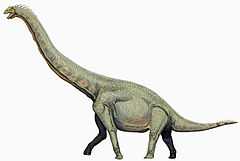Euhelopodidae
| Euhelopodids | |
|---|---|
 | |
| Life restoration of a Euhelopus zdanskyi | |
| Scientific classification | |
| Kingdom: | Animalia |
| Phylum: | Chordata |
| Clade: | Dinosauria |
| Suborder: | †Sauropodomorpha |
| Clade: | †Somphospondyli |
| Family: | †Euhelopodidae Romer, 1956 |
| Type species | |
| †Euhelopus zdanskyi Wiman, 1929 | |
| Genera | |
|
Euhelopus | |
Euhelopodidae is a family of sauropod dinosaurs which includes the genus Euhelopus. The family name was first proposed by American paleontologist Alfred Sherwood Romer in 1956. The four genera Chiayusaurus, Omeisaurus, Tienshanosaurus, and Euhelopus were the original proposed euhelopodines (subfamily Euhelopodinae). Other Chinese genera, such as Mamenchisaurus, used to be placed within this family, but are now in Mamenchisauridae. However, the traditional Euhelopodidae has been abandoned by many taxonomists for the time being. There may be such a family, but currently Jurassic and Cretaceous Asian sauropods are poorly known and have not yet been subjected to many detailed analyses, so it is unknown if there really is a Euhelopodidae of more than Euhelopus.[1]
Michael D'Emic (2012) formulated the first phylogenetic definition of Euhelopodidae, defining it as the clade containing "neosauropods more closely related to Euhelopus zdanskyi than to Neuquensaurus australis". The phylogenetic analysis conducted by the author indicated that such defined Euhelopodidae, in addition to Euhelopus itself, contained genera Qiaowanlong, Erketu, Daxiatitan, Tangvayosaurus and Phuwiangosaurus as well.[2]
References
- ↑ Wilson, Jeffrey A.; and Upchurch, Paul (2009), "Redescription and reassessment of the phylogenetic affinities of Euhelopus zdanskyi (Dinosauria:Sauropoda) from the Early Cretaceous of China", Journal of Systematic Palaeontology 7 (2): 199–239, doi:10.1017/S1477201908002691.
- ↑ D'Emic, Michael D. (2012), "The early evolution of titanosauriform sauropod dinosaurs", Zoological Journal of the Linnean Society 166 (3): 624–671, doi:10.1111/j.1096-3642.2012.00853.x
Further reading
- Romer, A. S. (1956), Osteology of the Reptiles, Chicago: University of Chicago Press, pp. 1–772.
- Royo-Torres, R.; Cobos, A. & Alcala, L. (2006), "A Giant European Dinosaur and a New Sauropod Clade", Science 314 (5807): 1925–1927, doi:10.1126/science.1132885, PMID 17185599.